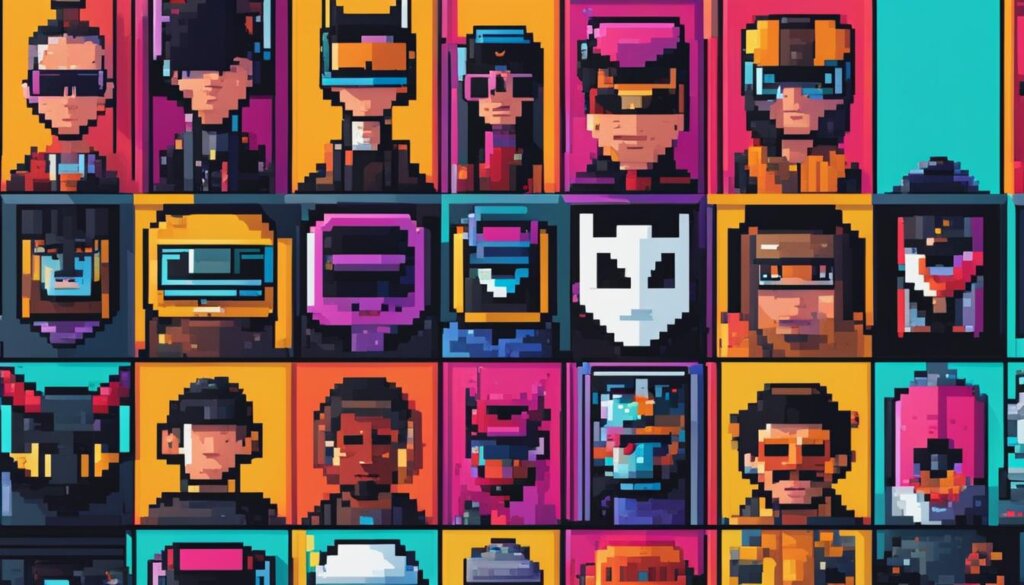Table of Contents
Non-fungible tokens (NFTs) have taken the digital world by storm, revolutionizing the way we perceive and interact with digital art and collectibles. These unique digital assets have distinct properties that differentiate them from other cryptocurrencies like Bitcoin or Ethereum. Built on blockchain technology, NFTs provide a new level of digital ownership and have attracted a crypto audience eager to explore the possibilities they offer.
Digital artists are among the biggest beneficiaries of NFTs, with many experiencing unprecedented sales and recognition for their work. NFTs have paved the way for a new era of creativity and entrepreneurship, empowering artists to monetize their digital creations and establish a name for themselves in the digital art space.
In this article, we delve into the world of NFTs, exploring their unique properties, the impact they have had on the digital art and collectibles market, and the immense potential they hold for digital artists. Join us as we unravel the fascinating world of NFTs and discover the limitless possibilities they offer.
What is NFT?
NFT, short for non-fungible tokens, refers to cryptographic assets created using blockchain technology. Unlike fungible assets such as Bitcoin or Ethereum, NFTs cannot be exchanged or traded equivalently. They possess unique properties that make them irreplaceable and non-interchangeable, setting them apart from physical currencies and cryptocurrencies.
While physical currency and cryptocurrencies are fungible, NFTs represent digital assets with distinct characteristics and features. NFTs have revolutionized the digital world by enabling the ownership and trading of one-of-a-kind digital items. These unique properties allow for the authentication and verification of digital ownership, making them highly valuable and sought-after.
NFTs are cryptographic assets created using blockchain technology. They are non-fungible, meaning they cannot be exchanged or traded equivalently. Unlike traditional currencies and cryptocurrencies, NFTs represent unique digital assets with distinct properties and characteristics.
NFTs have emerged as a game-changer, empowering creators and artists to monetize their digital creations. They have opened up new avenues for digital artists to sell their artwork directly to collectors, eliminating intermediaries and revolutionizing the art market.
For example, digital artists can mint their artwork as NFTs, ensuring the uniqueness and originality of each piece. These NFTs can then be bought, sold, and traded on specialized platforms, creating a thriving marketplace for digital art collectors.
Unique Properties of NFTs
- NFTs are indivisible and cannot be broken down into smaller units. Each NFT represents a distinct and whole entity.
- NFTs are verifiable and traceable, thanks to the transparent nature of blockchain technology. The ownership and transaction history of NFTs can be easily verified and validated.
- NFTs can store metadata and additional information, providing a deeper context and story behind the digital asset.
- NFTs can have smart contract functionality, enabling creators to earn royalties or set specific conditions for future sales.
NFTs have opened up a world of possibilities across various industries. From digital art and collectibles to virtual real estate, music, and even virtual fashion, NFTs have proven to be a versatile and transformative technology.
The unique properties of NFTs, such as indivisibility, verifiability, and the ability to store metadata, have made them a game-changer across industries. From digital art to virtual real estate, NFTs have revolutionized the way we perceive and trade digital assets.
Key Features of NFT
NFTs, or non-fungible tokens, have several key features that make them unique and valuable in the digital world. Let’s explore these features:
- Digital Assets: NFTs represent digital assets such as artwork, music, and games. These assets can be bought, sold, and owned digitally, providing a new way to collect and invest in unique pieces of digital content.
- Blockchain Technology: NFTs are created and stored on blockchain technology. This ensures the authenticity and ownership of the digital assets. Each NFT has a unique digital fingerprint that verifies its originality and prevents forgery or manipulation.
- Uniqueness: Unlike cryptocurrencies like Bitcoin or Ethereum, which are fungible and interchangeable, NFTs are unique. Each NFT has distinct properties and cannot be exchanged on a one-to-one basis with other NFTs or cryptocurrencies.
- Exchange and Marketplace: NFTs are exchanged on specialized platforms and marketplaces. These platforms allow users to buy, sell, and trade NFTs using cryptocurrencies like Bitcoin. One popular example of an NFT marketplace is Cryptopunks, where users can acquire and store unique collectibles with proof-of-ownership.
To further illustrate the key features of NFTs, let’s take a look at the Cryptopunks marketplace:

Cryptopunks is an example of an NFT marketplace that offers a wide range of unique digital collectibles. Users can browse through and purchase various Cryptopunks characters, each with its own distinct features, style, and rarity. The ownership of these digital collectibles is verified and recorded on the blockchain, providing proof-of-ownership and ensuring their uniqueness.
With these key features, NFTs have revolutionized the way we perceive and own digital assets. They have opened up new opportunities for artists, collectors, and investors in the digital space, transforming the concept of ownership and value.
History of Non-Fungible Tokens (NFTs)
NFTs have a fascinating history of innovation and evolution. While they may seem like a recent phenomenon, their roots can be traced back to earlier projects and experiments.
One of the earliest attempts to create NFT-like functionality was through Colored Coins. Introduced in 2012, Colored Coins allowed users to associate unique attributes and values with specific Bitcoin transactions. While it laid the groundwork for NFTs, it had limitations as it could only represent certain values that were agreed upon by everyone.
Another contender for the first NFT title is the creation of a work called “Quantum” by Kevin McCoy in 2014. It was minted on the Namecoin Blockchain and is seen by some as an early example of a non-fungible token.
The implementation of NFTs gained mainstream attention with the advent of Cryptokitties in 2017. The project allowed users to buy, sell, and breed digital cats, which quickly became a worldwide phenomenon. The high prices fetched by these digital felines brought NFTs into the spotlight and showcased the potential of unique digital assets.
Since Cryptokitties, numerous successful NFT projects have emerged, spanning different industries and areas of interest. These projects have leveraged the power of NFTs to revolutionize the way digital assets are bought, sold, and owned.
| NFT Projects | Industry/Area |
|---|---|
| Cryptopunks | Digital Collectibles |
| Decentraland | Virtual Real Estate |
| Rarible | Digital Art |
| NBA Top Shot | Sports Collectibles |
| SuperRare | Digital Art Marketplace |
These NFT projects have not only captured mainstream attention but have also opened up new possibilities for artists, creators, and collectors alike. The world of NFTs continues to evolve and innovate, presenting exciting opportunities in various creative and digital spaces.
How Does NFT Work?
NFTs, or non-fungible tokens, operate on the Ethereum blockchain as individual tokens that store valuable information. Unlike cryptocurrencies such as Bitcoin or Ethereum, NFTs are unique and non-interchangeable, similar to physical works of art. Each NFT holds distinct data that enables easy verification and validation of ownership and facilitates the transfer of tokens between owners. This functionality allows NFTs to be bought and sold in a similar manner to traditional art forms.
Just like physical artwork, the value of NFTs is determined by market demand. Artists and creators mint their works as NFTs, adding an additional layer of authenticity and scarcity to their creations. The market for NFTs has seen phenomenal growth, with collectors and enthusiasts eagerly seeking out these one-of-a-kind digital assets.
One of the key aspects of NFTs is their ability to validate ownership. The blockchain ensures that the ownership of an NFT can be proven beyond a doubt, eliminating the possibility of counterfeit or duplicate creations. This verification process instills confidence in buyers and collectors, knowing that they are acquiring a genuine and unique piece of digital art or collectible.
The transfer of NFTs between owners is also facilitated by the blockchain technology. By using smart contracts, ownership transfers can be executed seamlessly and securely. This eliminates the need for intermediaries and reduces the risk of fraud or disputes over ownership.
NFTs provide a revolutionary way to own, buy, and sell digital assets. With their unique properties, market demand, and blockchain-based verification, they have unlocked a new era of digital ownership and value.
By leveraging the power of blockchain technology, NFTs have transformed the way we perceive and interact with digital assets. They have created a thriving market for digital art, collectibles, and various other unique creations. As the demand for NFTs continues to grow, it’s becoming increasingly clear that this digital revolution is here to stay.
| Advantages of NFTs | Disadvantages of NFTs |
|---|---|
| NFTs enable artists to monetize their digital works | High energy consumption associated with blockchain technology |
| Provides verifiable ownership and scarcity | Requires knowledge of cryptocurrency and blockchain for participation |
| Eliminates the need for intermediaries in transactions | Potential for market saturation and dilution of value |
| Expanding opportunities for digital creators and artists | Lack of regulations and potential for scams |
Examples of NFT
The NFT world offers a wide range of digital collectibles that have captured the attention of enthusiasts and investors alike. From domain names to games, essays to sneakers, there is a diverse array of digital content that can be tokenized as NFTs. Let’s explore some notable examples and use cases in the NFT ecosystem.
1. Digital Collectibles
One of the most popular applications of NFTs is in the realm of digital collectibles. Artists and creators can tokenize their digital artwork, granting them ownership rights and the ability to monetize their creations. These NFTs can be traded on various platforms, allowing collectors to build curated collections of unique digital art pieces.
2. Gaming Items
NFTs have also gained significant interest in the gaming industry. Players can acquire and own unique in-game items and assets that hold real-world value. These NFTs enhance gameplay experiences and can be bought, sold, and traded by players, creating a vibrant market for virtual assets.
3. Investment Assets and Collaterals
With the rise of decentralized finance (DeFi), NFTs have emerged as investment assets and collaterals. Users can purchase NFTs that represent fractional ownership in physical assets such as real estate, fine art, or luxury goods. These securitized NFTs provide investors with a new avenue to diversify their portfolios and participate in alternative investment opportunities.
4. Celebrity Memorabilia
Celebrities have also embraced the NFT movement, releasing unique memories and artwork as securitized NFTs. Figures like Snoop Dogg and Jack Dorsey have made successful forays into the NFT space, offering exclusive digital content to their fans and followers.
5. NBA Top Shot
NBA Top Shot has revolutionized the way basketball highlights are consumed and traded. The platform offers digitized video reels of NBA game highlights, transformed into NFTs. These collectible moments have generated millions in sales, attracting basketball enthusiasts and collectors who can own a piece of their favorite players’ on-court brilliance.
The table below provides a summary of the diverse examples of NFTs in different industries:
| NFT Examples | Industry |
|---|---|
| Digital Art | Art and Collectibles |
| In-Game Items | Gaming |
| Securitized Assets | Investment and DeFi |
| Celebrity Memorabilia | Entertainment |
| NBA Top Shot Moments | Sports |
These examples showcase the vast potential of NFTs and the different industries they have permeated. As the NFT world continues to evolve, we can expect to see even more innovative applications and opportunities arise.
NFTs vs. Crypto and Fiat Currencies: Understanding the Difference
When it comes to digital assets, NFTs, or non-fungible tokens, stand apart from cryptocurrencies and fiat currencies. While cryptocurrencies like Bitcoin and fiat currencies such as the pound or dollar are primarily used for transactions and are fungible, NFTs represent a unique piece of artwork or digital asset.
What sets NFTs apart is their digital footprint, which provides verifiability and authenticity. Each NFT has a distinct and irreplicable digital signature that proves its ownership and originality. This makes NFTs highly valuable in industries like fashion, digital art, and collectibles. Unlike cryptocurrencies and fiat currencies, NFTs cannot be easily exchanged or interchanged due to their unique properties.
With NFTs, collectors and investors can own a one-of-a-kind digital asset, such as a rare artwork, without worrying about it being fungible or interchangeable. The verifiability and authenticity of NFTs ensure that each piece has a unique and unforgeable identity, adding value and rarity to the digital asset. This uniqueness has opened up new avenues for artists, creators, and collectors, revolutionizing the way we perceive and trade digital goods. NFTs have emerged as a game-changer, offering endless possibilities in the digital world.
FAQ
What are NFTs?
NFTs, or non-fungible tokens, are unique digital assets created using blockchain technology. Unlike cryptocurrencies like Bitcoin or Ethereum, NFTs cannot be exchanged or traded equivalently. They have unique properties that make them irreplaceable and non-interchangeable. NFTs represent digital assets with unique properties, such as art, music, and games.
How do NFTs work?
NFTs are created on blockchain technology, providing an authentic certificate of ownership. They are exchanged using cryptocurrencies like Bitcoin on specialist sites. NFTs have unique data that allows easy verification and validation of ownership. This makes it possible to buy and sell NFTs like other forms of art.
What are some examples of NFTs?
NFTs encompass various digital collectibles like domain names, games, essays, and sneakers. They are used for digital content, with creators benefiting from ownership rights and monetizing their creations. NBA Top Shot is a notable example that has generated millions in sales through digitized basketball highlight video reels.
How do NFTs differ from cryptocurrencies and fiat currencies?
NFTs represent unique digital assets or pieces of artwork, while cryptocurrencies and fiat currencies are primarily used for transactions and are fungible. NFTs have a digital footprint that provides verifiability and authenticity, making them valuable in industries like fashion, digital art, and collectibles.












